Spiderman meta-update
This is an animated news story that relies heavily on metaphor about a live performance based on an animated character who was appeared first as a series of static images.
This is an animated news story that relies heavily on metaphor about a live performance based on an animated character who was appeared first as a series of static images.
The information and analysis contained in this faux-rap battle about the issues discussed at the recent G20 is more detailed than many actual newscasts
.
One can only assume that this analysis of the Wikileaks news story would make Bertolt Brecht very happy.
by Michael Wheeler
Fresh on the heels of our conversation about the the website Xtranormal and the impact it was having on online performance, comes a different take on incorporating a global audience into online performance.
Taipei-based Next Media Animation (NMA) bills itself as “the largest full-service 3D animation studio in Asia” and the company’s corporate profile boasts it can provide “animation to order” with a turn around time of “hours”. This studio doesn’t just create digital content to-order for other broadcasters however, it also broadcasts it’s own material via NMA.TV. This website animates some of the the world’s most high-profile news events, in what can only be described as Brechtian perspective, with most world powers being represented by archetypes, metaphors, or signifiers.
To further introduce this news coverage to an online audience, the website is heavily integrated with its facebook page (every broadcast finishes with the newscasters urging viewers to “find us on facebook”). Anyone who “likes” the page has the opportunity to become part of the news by having an avatar of themselves represent one of the characters in an upcoming broadcast. At the end of the news segment, the “guest star” is revealed with a quick recap of their “performance”.
Just to be clear – if you get your news through this medium through social media tools – it is possible that you can virtually become part of the news in a credited performance and never leave your computer.
If it’s not theatre – it’s something right?
by Michael Wheeler
A few months ago, as part of a post on the internet and theatre, I concluded with a video made on the online storytelling site xtranormal about the irrational behaviour driving the sales of iPhone 4s. This video has gained a lot of traction, and in particular the sequence where all of the features of a different phone are mentioned while the crazed shopper continues to reply in a robotic even-keeled voice, “I Don’t Care.”
Today xtranormal viral videos made for free on the internet seem to be everywhere. No actors, designers, or live audience to worry about. Just you as writer/director and a cast that isn’t going to give Johnny Depp a run for his money anytime soon, but might run off with Hello Kitty if you don’t keep an eye on em. Below are the two xtranormal videos doing the rounds in the world of North American theatre and Toronto municipal politics – two of our faves in this space.
You should be on Broadway
Rob Ford’s Transit Plan (Note the adoption of the “I don’t care” meme in this video also)
by Michael Wheeler
In the winter of 2009 I attended a theatre history lecture at Toronto Free Gallery by Alex Fallis on The Progressive Arts Club and the theatre created by artists who were opposed to many of the anti-civil rights policies enacted by Prime Minister Bennett in the 1930s. These people proved to be so fascinating that I elected to create with Praxis Theatre a show about them, Tim Buck 2, which played at The Tranzac Club as part of the 2009 Toronto Fringe Festival.
This led to our Harbourfront Centre HATCH workshop Section 98, which expanded the scope of our work to some other instances when civil rights proved to be a contentious issue for Canadians: namely the FLQ crisis, the Air India bombing, Omar Khadr, and the treatment of Afghan detainees captured by Canadian soldiers. Both the Fringe show and our HATCH workshop were extremely useful in terms of exploring who these people were, what they were concerned about, and the complexity of balancing our country’s commitment to civil rights and concerns of national security.
Unfortunately, neither of these initial explorations did an awesome job of storytelling. So this spring and summer we went back to the drawing board with this project and thought about how to move beyond ‘staged dramaturgy’ and into narrative-based work informed by these themes.
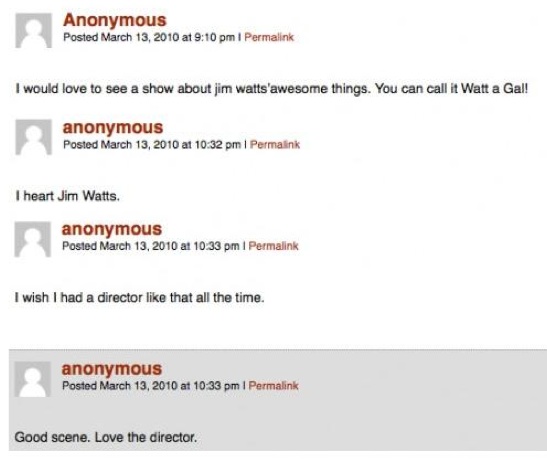
The most consistent positive feedback from our open source creative process revolved around curiosity and fascination with Eugenia “Jim” Watts.
Both presentations involved an online component that allowed the audience to participate with or respond to our work: Tim Buck 2 asked the audience to return to the website to learn the results of a poll conducted at the conclusion of a debate at the end of the show. These posts also generated some interesting conversations in their comments sections.
Section 98 was more intrinsically attached to the internet with Praxis Artistic Producer Aislinn Rose acting as Open Source Project Leader, sharing parts of our process online, actively seeking participation from our community, and developing an infrastructure that encouraged live feedback over the web or through texts during the workshop presentation.
There were also quite a few normal conversations, in person, with live human beings who had seen the show(s).
The first conclusion was that the core personality we had explored that generated a unique resonance with both audiences and ourselves was Eugenia “Jim” Watts, played in both productions by Margaret Evans. A core political organizer and theatre director in 1930s Toronto, she co-directed the legendary civil rights play banned by Bennett, Eight Men Speak, and later went on to be one of two women serving with the Mackenzie Papineau Brigade in the Spanish Civil War where she was an ambulance driver. She was also involved with a number of other projects; she was very busy, and interesting, and worth being the impetus for a work of art.
The second conclusion was that this piece required a playwright, and a good one. This playwright would preferably be an artist who had experience creating theatre about historical events for a contemporary audience (we talked a lot about avoiding a ‘bio pic’) and a passion for social justice.
So it is with much pleasure and excitement we announce Dora-winning playwright Tara Beagan has joined Praxis Theatre in continuing our work on this latest iteration, . Tara and I worked together for two years on Crate Productions’ The Fort at York, and she also acted as an outside eye for Praxis on our Toronto Fringe 07 co-pro, Dyad, but Jesus Chrysler is her first official work with Praxis Theatre and we are thrilled to welcome her.
Jesus Chrysler will be presented at The Factory Theatre as part of Lab Cab on Saturday September 18 and Sunday September 19 at 5pm. The entire festival is free with all manner of art and experiences presented by over 50 artists throughout every nook and cranny of The Factory from noon to 6pm each day. We invite you to come check out the whole festival and save your 5pm – 5:20pm slot for us. This being a Praxis show, we’ll definitely welcome your feedback online or in person, with a particular emphasis on your thoughts about our transition to a script based work about a single individual.
Hope to see you there!
Hipster dance classes are taking off in LA. Photo credit nytimes.com
by Michael Wheeler
The past week has hosted some novel conversations on contemporary theatre and how it is developing. Most interesting is how all of these perspectives are contributing to a larger conversation about what form theatre can take to engage, well, anyone under 40 who isn’t already in theatre. Here are some recent highlights:
In The Guardian, Lee Hall laments that the 20-30% arts funding cuts will bring down the curtain on British theatre’s golden age. At the core of his argument is that the new budgets will leave theatres unable to take artistic risks or be able to nurture and mentor the next generation of artistic talent:
“The post-1945 consensus understood this completely. The need for municipal theatres, the need to fund the experimenters (who of course become the next establishment), the need for national institutions, the need to represent the rich diversity of our society – allowing a place where we can all become richer by including the excluded – was centrally important to the interventions made. But more than this, there was an implicit understanding that our greatest talent could not be nurtured without support.”
Meanwhile on the other side of the Atlantic, Huffington Post critic Monica Westin has a decidedly more upbeat perspective on Why Hipsters Will Save Theater in her review of David Cromer’s Cherrywood. Her thesis proposes that the ironic disengagement that permeates hipster culture has the potential to create a new kind of theatre, that combines both “alienation effect” and “happening”. They (we), are capable of creating and enjoying this new approach to art as “the first generation of bohemian youth culture that’s not going to look like idiots–like the hippies and the punks–later for pretending to have all the answers, when all we had was a new way of dressing stupid.”
“But it’s the combination of the alienation effect and the happening that makes Cherrywood so important. In 1968 Peter Brook declared in The Empty Space that “The alienation effect and the happening effect are similar and opposite–the happening shock is there to smash through all the barriers set up by reason, alienation is to shock us into bringing the best of our reason into play… leading its audience to a juster understanding of the society in which it lived, and so to learning in what ways that society was capable of change.” How does alienation work? According to Brook is can use any rhetoric: “It aims continually at pricking the balloons of rhetorical playing–Chaplin’s contrasting sentimentality and calamity is alienation.” Brook couldn’t imagine a theater piece in which both could happen at once; life now demands this of theater, and Cherrywood delivers it.”
Of course you can’t be a theatre-conscious hipster looking for the latest, coolest, cheapest tickets you can find without this new Ap for your iPhone, which lists all the Broadway and Off Broadway shows and discount rates that TKTS has available each day. This sort of technology is probably much better suited to attract the new generation of potential theatregoers that make same-day plans and aren’t looking to fork out an arm and a leg for a night out on the town. Is there the potential for indie companies to collaborate through this same technology? Now that we have thrown out the notion that we have to perform in the same space to have marketing/ticketing alliances shouldn’t we be all over this?
If you used your iPhone to get tickets, maybe you should keep using it once the show starts? Over at 2amtheatre they had a multi-perspective post and conversation about the type of interactive, invite the audience to communicate with their PDA during the performance type of stuff Praxis was experimenting with in March at Harbourfront Centre. The consensus opinion seemed to be that imposing tweets on pre-existing scripts was a recipe for disaster, but that tweeting during shows had the potential to expand the medium if the pieces were built with this level of interactivity in mind. Travis Bedard provided some questions that should be considered while choosing to make work this way:
“But what can this technology enable for a playwright or deviser creating NEW work?
This is another possible tool on the utility belt for writers. It is indeed another entire plane of existence for characters.
Can extra-stage characters exist only in the Twitter-verse? Can the audience team up with one another for or against the stage characters?
What does the interaction between the sequestered, in-space audience and the free range Twitter audience look like?”
How well can the playwright and director control that?”
This last question is probably why there hasn’t been a HUGE amount of experimentation with this sort of thing. It is a process that confers less power to both playwright and director. Unproven methods that reduce the influence of the artistic leaders of a project are tough to get off the ground. I’m also a little confused about why Twitter is the only option being discussed as a technology to do this sort of thing. Facebook statuses, texts, tweets, IM, email, skype – we’re all using interactive digital technologies to improve our capacity to communicate. Why stratify it to a single tool exclusive to, well, hipsters? If we’re going to save theatre, we’re still going to do it with everyone else. It’s also important to remember what can happen when we get obsessed with a particular brand of technology.

Melissa Hood looks over her notes during rehearsal. Photo by Hugh Probyn
by Aislinn Rose
In October 2009, Struts and Frets blogger Kris Joseph posted On theatre in society: porosity in response to Mike Daisey’s How Theater Failed America, about the current dysfunction of funding models for American theatre, as well as Chris Ashworth’s Toward a New Funding Model for Theater, in which he argues that “the process is the product”, and therein lies a new approach to funding. Joseph asserts in his post that he is, “now more convinced than ever that theatre can and must distinguish itself from film, TV, and new media by being completely porous to its audience.” He goes on to write that theatre artists must share their process by becoming integral parts of the communities where they work, and that the community should feel completely part of that work.
The post inspired an equally interesting conversation in its comments section, with Praxis Co-Artistic Director & Director of Section 98 Michael Wheeler commenting that the work we were doing with Section 98’s Open Source Theatre project was in part an attempt to make our process integral to our relationship with our audience, in preparation for our work-in-progress presentation for Harbourfront Centre’s HATCH season. We though the issues we were addressing would benefit from discussion and wanted to get our community involved as early in the process as possible.
Another commenter wrote to say that he normally runs screaming from the room when it comes to “art as process” work, with only a few exceptions. However, he was in complete agreement with a point made by Ashworth (in reference to sharing the development process with the audience) about editing out “the boring bits”. Sounds like a good idea, doesn’t it? Easier said than done I think.
It’s been a few weeks since our HATCH presentation and we’re still sorting through the feedback. In an effort to open ourselves up to our community, we recorded our process online and encouraged audience members to text us during the show with the texts posted live to our blog throughout the presentation, and we asked our audience members to continue sending us their feedback after they’d gone home and had a chance to reflect. Some chose to return to our blog with that feedback, and others emailed us or sent messages via Facebook.
Here’s our best attempt to provide an unbiased overview of the synthesis of this feedback under the major categories it addressed.
Open Source/Interactive:
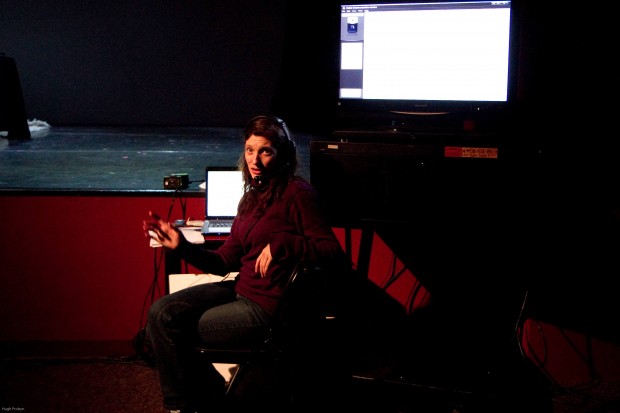
Assistant Director Laura Nordin operated the texting software during the performance and transferred the comments to the website. Photo by Hugh Probyn
A text received during the show:

An unsolicited Facebook message after the show:

Do I want to meet? Hell yes! I had to google “experience design” to find out it was an actual thing.
And in response to the texting:

And from a texter with a smart phone with access to our blog throughout the show:

And from a post-show blogger:
![]()
The Q&A at the end of the show yielded a number of comments on this topic, with many saying they found the texting to be distracting, or that they prefer to lose themselves in the theatre rather than participating in every day life activities like texting. Others really liked that they were able to communicate with us throughout the show, but they wanted to see it further integrated into what they actually see onstage. Lots to think about here!
Multiple Plot Lines:
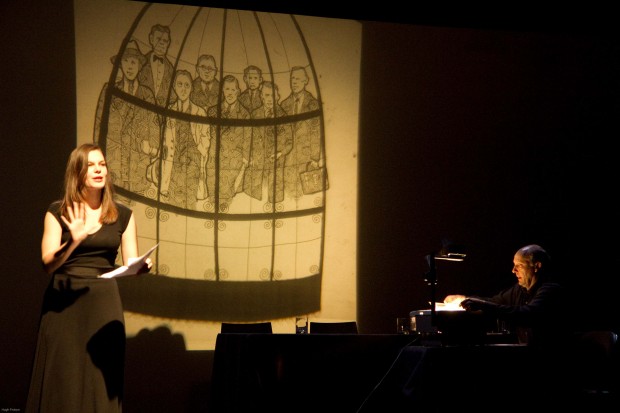
Greta Papageorgiu presents “Section 98 for Dummies”. Photo by Hugh Probyn
Section 98 was investigating the history of Civil Rights in Canada, with a particular eye on the Communists of the 1930s, the FLQ and the War Measures Act in the 1970s, and Afghan Detainees in the modern era. Some audience members found the inclusion of so much information to be confusing, or questionable:


The audience at the Q&A seemed to divide neatly into two camps on this issue. On the one side there were people who felt that the multiple topics were too scattered and they were having trouble tying it all together. Another perspective suggested this was not the time to condense our story yet… that we should “keep blowing it up and making us make the connections ourselves (which I’m sure we’ll continue to do for several days)” as one participant commented. Or, as it was put another way, “I kind of like you throwing a bunch of shit up there… you’re giving us homework”.
General’s Testimony:

Photo of the Three Generals from my iPhone during rehearsal.
As part of the presentation, we also included verbatim texts of the testimony given by General Rick Hillier, Lieutenant-General Michel Gauthier, and Major-General David Fraser after the explosive testimony of Richard Colvin, in which he alleged that Canadian Soldiers knowingly transferred Afghan detainees to torture in Afghan prisons. Here’s some of what we got during the show:



So we discovered that most people found this material to be deadly boring (including my mom). There were, however, a few people who found the transcripts to be interesting, while others suggested we could absolutely continue working with them… once we had sculpted it with our point of view. “There’s no such thing as neutral.” This is fascinating to me since we had been so concerned about taking the material out of context and were committed to presenting it exactly as we found it.
Omar Khadr:
Image by Darren O’Donnell
Omar Khadr also caused some disagreement. I am, of course, not referring to the real Omar Khadr, the one who was captured at the age of 15 and lives in Guantanamo Bay. I’m referring to another of our Open Source Theatre commenters who went by the moniker of “Omar Khadr” in response to Open Source Entry # 4: Checking for a Pulse. Some of these comments were included in our show. Here are some of the responses this material generated, in the order in which they were received:
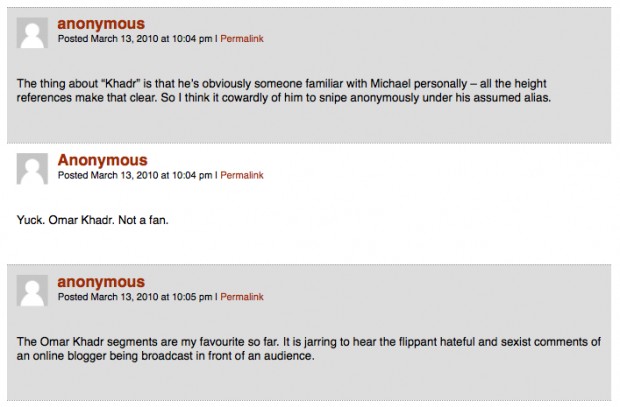
Some thought the sections to be “extraneous” or “questionable”, while another said, ““Omar” really turned out to be a lynchpin of the show.”
Fake Omar requested that we not take him out of context so we recorded his text using an imagined internet/robot voice. While people couldn’t agree on whether or not we should have included this material, most could agree that the robot voice should go.
Jim Watts
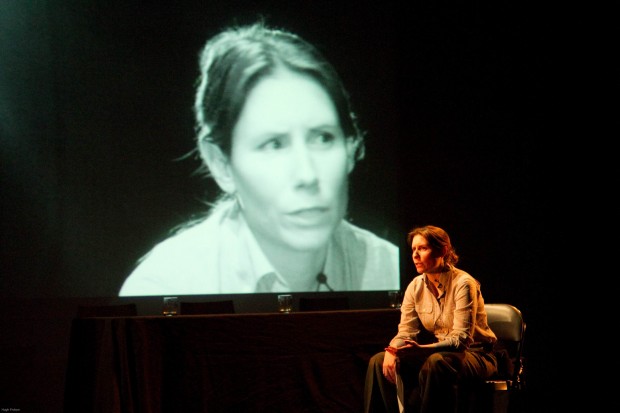
Margaret Evans as “Jim” Eugenia Watts. Photo by Hugh Probyn
If there’s one thing that most people could agree on, it was Communist/Theatre Artist/Revolutionary Jim Watts… the kind of character I would have liked to encounter in Canadian History classes in public school. Here’s what people had to say about her:


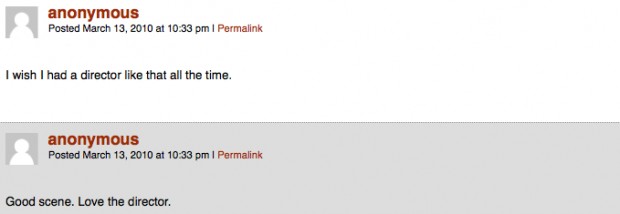
More post-show feedback continued in this vein, with suggestions that Jim really is the anchor of our show. To me, this is one of the most successful aspects of this workshop because we were fascinated by Jim while developing Tim Buck 2 when this show started at the Fringe, but she really didn’t emerge as a centrepiece in that iteration of the project.
What Now?
So, what do we do when half of our audience tells us they hate something about our show, while the other half says, “it was our favourite part”? One commenter may have addressed the challenge of conflicting advice best:
“If I start commenting on Linux, [an open source, collaboratively developed operating system] no one is going to listen, for very good reasons (I don’t know much about code.) So, how, in this world of aesthetic and political difference, can you tell […] who to listen to – who shares any values.”
This question of “who to listen to” is a great one, and will be on our minds as we dig deeper into all of the feedback. Which of the responses can we add to our “source code” to enhance our work, and which responses will “crash” it? As we continue in our efforts to be “porous” with our audience, please stay tuned for Part 2 where we discuss our own responses to the feedback, and where Section 98 is headed.
Dave Tompa on how he scored the juicy role of an NDP Member of Parliament in Praxis Theatre’s Section 98
Praxis Theatre’s one-night-only workshop presentation of Section 98 is finally here. Do you have your tickets yet? Last night we had an invite-only dress rehearsal, and we learned a lot. In particular, after all these years of audiences being told to turn their cell phones off, we’re finding it a bit of a challenge to encourage you not only to leave them on, but to actually put them to use during the show. So we’re hoping to see you and your cell phones at the Harbourfront Centre tonight at 8pm.
Check out Praxis Theatre’s Co-Artistic Director Michael Wheeler talking to Harbourfront about our “Open Source” show, and why you need to bring your phones. See you tonight!
Harbourfront Centre’s Upfront talks “Open Source Theatre” with Praxis Co-Artistic Director, Michael Wheeler
Tech Day in 2 Minutes or Less
Shot at the Harbourfront Centre, Toronto, 2010 by Brittney Filek-Gibson, edited by Mike Last
by Aislinn Rose
We’re here on Day Three of HATCH at the Harbourfront Centre Studio Theatre, preparing for our work-in-progress presentation of Section 98. Some of you are familiar with the nature of “Tech Day”, but part of the purpose of our Open Source Theatre project is to reach a wider, non-theatre going audience… so for those of you who are not familiar with tech days, our Stage Coordinator Brittney Filek-Gibson – also known as BFG, also known as Praxis Theatre’s Social Media Sheriff – has created an amazing little video for you, that I like to call “Tech Day in 2 Minutes or Less”. In reality, tech days are much longer. 8 hours longer. Sometimes 12.

Don't go to the theatre regularly? Tell us why in the comments section and we'll give you a free ticket to our show!
So, to all you non-theatre goers… did you have any idea that theatre artists and technicians go through all of this just to make things pretty for your arrival? If you don’t normally go to the theatre, or if you used to go to the theatre but don’t anymore… we want to hear from you. What’s keeping you away? What can we do to get you here? Tell us why you don’t go to the theatre in the comments section below, and we’ll give you a free ticket to our show this Saturday night!
My mum has had a really hard time getting my dad to the theatre ever since she took him to a production of Man of La Mancha over 25 years ago, and a man “pranced around the stage on a broom pretending he was riding a horse”. To make matters worse for my dad, it was Good Friday and all the bars were closed.
Recent Comments